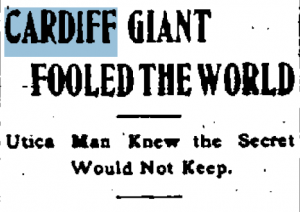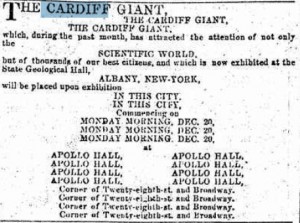There is a sucker born every minute
“There is a sucker born every minute.” This saying has been attributed to P.T. Barnum; however, upon further research I discovered that the actual person associated with this was a deception in itself. It was not a quote of the famous master of circus ceremonies, but rather a quote of David Hannum, a banker and owner of the Cardiff Giant.
George Hull of Binghamton, New York was the original hoaxer behind the creation of the Cardiff Giant. In 1868, Hull secretly commissioned a giant life-like statue of a man created out of gypsum and had it buried on the farm of William Newell, his cousin in Cardiff, New York. A year later, Hull ordered two workmen to dig a well at the exact location of the statue. Upon unearthing the gigantic structure, the bewildered laborers subsequently announced to the community the discovery of a petrified giant. Hull and his cousin carefully staged an excavation and erected a tent at the site. Soon word spread throughout the country and wagonloads of people arrived to see the “Giant” at the Newell farm for 25 cents a person. Hull quickly raised the fee to 50 cents a person when stage coaches started making four round trips a day from Syracuse. It was at this point that David Hannum, the head of a syndicate, purchased the giant and had it moved to Syracuse. Subsequently Hannum started charging a fee of $1 for viewing.
Hoax that fooled the world
Everyone from clergymen, professors, farmers, scientists, and professionals came to see the figure. They suspected that it was either a fossilized giant human or an ancient statue. No one had any idea that it was a premeditated hoax! I even saw this statue on display at the Farmer’s Museum in Cooperstown, New York with my family back in the 1970s. By then the truth of this stone figure had been unveiled, but it still drew interest.
P.T. Barnum, known for his circus and freak shows, offered to buy the statue for $50,000 but was turned down. So Barnum had one built for his own show and told the public that Hannum’s statue was a fake. To the people who ran to see Barnum’s statue Hannum stated, “There is a sucker born every minute.” (It is suggested that Hannum who purchased the original statue from Hull actually believed that his was real!) (details obtained from Historybuff.com)
This brief story reminds me of the sensationalism of some recent television shows. Such as those that depict Big Foots, aliens, and even mermaids. While there might be a thread of truth contained within each story, by and large the main thrust of the story is usually false or inconclusive. Such as in the case of the Cardiff Giant which was indeed dug up by workmen. However the story of the statue’s origin and how it got there was the deception. Recently I was glued to an Animal Plant program that aired over Memorial Day Weekend alleging to have discovered the beached body of a real mermaid. After an hour-long of sifting through evidence and learning about whale sonar, the program showed some footage claiming to be taken by a couple of kids. I don’t know if it was real or not. Efforts to search it on the internet came up with sites appearing to be blocked by the government. The video looked a lot like what one might see on a horror flick. The fact that one can create any image on camera these days negates proof of anything.
A famous agnostic
Recently my genealogy research of my Darrow family line led to the discovery of my 4th cousin 4 times removed, Clarence Seward Darrow (1857-1938), a famous Chicago lawyer. He is noted for being an “attorney for the damned” as he was a defense counsel in many criminal trials, most notably killers Leopold and Loeb, and Scopes Monkey Trial. Intrigued by this relative, I decided to flip through some of his writings.
This was when I discovered that he was also a noted agnostic, giving frequent lectures and debates on the subject. This was something that I did not know! One essay in particular that caught my attention was entitled, “Why I am an Agnostic.” A line that my old distant cousin wrote states:
“ I am an agnostic as to the question of God. I think that it is impossible for the human mind to believe in an object or thing unless it can form a mental picture of such object or thing.”
How I wish he had been a Roman Catholic! Reading about his biography on various sites, I discovered that his father was known as the town “atheist” and at an early age Clarence had become accustomed to defending his family honor. Many claim that such was the fuel behind his defense of lost causes and his prolific agnostic stance.
Being a relative, who is also addressing the issue of “a sucker born every minute,” I can’t help but want to address the agnostic rantings of my old cousin from the last century. Upon sharing this information, my husband stated, “He definitely knows the truth now!”
What St. Augustine has to say “On Seeing God.”
As human beings, we like to use scientific criteria to judge the veracity of a fossilized giant, big foot, alien, or beached mermaid, but when it comes to the spiritual realm we encounter difficulty. Like the old saying goes trying to compare apples and oranges. What rings out in my mind is the letter by St. Augustine of Hippo entitled, “On Seeing God.” The apples and oranges are like what St. Augustine says, “For beauty is seen, but virtue is declared; the former is perceived by the eyes, the latter by the mind.” St. Augustine gives a great rebuttal:
“…God is by nature invisible, and not only the Father, but also the Trinity itself, one God, and because He is not only invisible but also unchangeable, He appears to whomever He wills and under the aspect that He wills, so that His invisible and unchangeable nature may remain completely within Himself.” Elsewhere in the same letter St. Augustine states: “It is not our power to see, but to His to appear.”
These are significant points about belief in God. One can understand that first and foremost God in His pure nature is not grasped by our human eyes or even conceived by any of our human abilities. But God can will to appear to whom He wants in whatever way He wants. This shows that indeed it is a gift to believe in God. But, St. Augustine is also quick to conclude that “God is not seen in any place but in the clean of heart.” It is a common quote to hear that the devil knows that God exists. But it takes a humble heart to accept God’s will for one’s life.
Where the material and spiritual meet
This is why earlier I had stated that I wished Darrow had been Catholic. My opinion is based on my own faith in case anyone has a problem with this. I like to quote how the Catholic faith bridges the gap between the spiritual and the material which is nicely explained by Christopher West in Theology of the Body for Beginners on his section titled, “The Sacramentality of the Body”:
“The Catholic faith, if you have not already noticed, is a very fleshy, sensual religion. We intimately encounter God through the action of the Holy Spirit upon ‘signs that draw from’ the material world: through bathing the body with water (baptism); anointing the body with oil (baptism, confirmation, holy orders, anointing of the sick); eating and drinking the Body and Blood of Christ (the Eucharist); the laying on of hands (holy orders, anointing of the sick); confessing with our lips (penance); and the unbreakable joining of a man and woman in ‘one flesh’ (marriage).
“How can we describe the ‘great mystery’ of the sacraments? They are composed of matter and are God’s chosen means by which, through the action of the Holy Spirit, we encounter God’s spiritual treasures. In the sacraments, spirit and matter ‘kiss.’ Heaven and earth embrace in a union that will never end…He wants to make His invisible, spiritual mystery visible to us so that we can ‘see’ Him.” (pp. 4-5).
Yes, “There is a sucker born every minute.” However, where our human senses and scientific method fail, God provides what is needed to help the spiritual and material meet. Such can be obtained through the Sacraments of the Church.
In today’s Gospel Jesus prays: “…that the world may believe that You sent Me.” (John 17:21)
As a footnote, George Hull, the creator of the Cardiff Giant, made a fortune off of the Cardiff Giant. However, according to the Binghamton Press, at the turn of the century, he ended up dying a lonely and pennyless man in the end.


